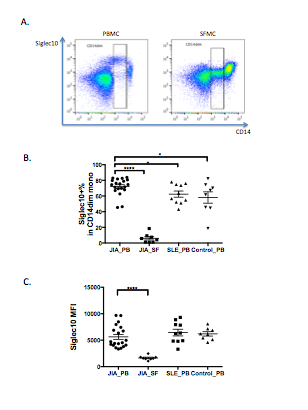Session Information
Session Type: Abstract Submissions
Session Time: 5:30PM-7:00PM
Background/Purpose: Monocytes plays a role in juvenile idiopathic arthritis (JIA). CD14dim monocytes have modulatory effects in innate and adaptive immune responses. Siglec-10, which is highly expressed on CD14dim monocytes, functions as an inhibitory receptor within the innate immune system. The interaction between Siglec-10 and its ligand CD24 could prevent tissue damage-induced immune responses. Siglec-G (murine Siglec-10 homolog) knockout mice developed increased clinical disease in mouse arthritis model, which suggests a role of Siglec-G/10 in pathogenesis of arthritis. IL-29 is a member of type III IFN family. Besides its antiviral and antitumor function, IL-29 also has immune-regulation function. In this study, we investigated the expression of Siglec-10 on CD14dim monocytes from synovial fluid (SF) and peripheral blood (PB) of JIA patients and assessed IL-29 as a candidate cytokine produced from the Siglec10-CD24 interaction.
Methods: A total of 42 patients, including 24 JIA, 10 systemic lupus erythematosus (SLE) and 8 controls were included. Siglec-10+CD14dim monocytes were sorted by flow cytometry to culture with or without human CD24 fusion protein. The expression of Siglec-10 on PB and SF monocytes was measured by flow cytometry. IL-29 mRNA expression was assessed by quantitative real-time reverse transcriptase-polymerase chain reaction.
Results: The percentage of synovial Siglec-10+CD14dim monocytes of JIA patients was significantly decreased compared with that from peripheral blood. Furthermore, the expression of Siglec-10 (Mean fluorescent intensity, MFI) was significantly lower on SF CD14dim monocytes when compared with PB CD14dim monocytes. Although the expression of Siglec-10 on PB CD14dim monocytes was similar in JIA, SLE and the control subjects, the percentage of Siglec-10+CD14dim monocytes from PB was higher in JIA patients compared with SLE patients and controls. IL-29 mRNA transcript in Siglec-10+CD14dim monocytes cultured with CD24 fusion protein in vitro was increased, relative to controls cultured without CD24 fusion protein.
Conclusion: Interaction between Siglec-10 and CD24 on CD14dim monocytes may trigger the production of IL-29 which may mediate immunoregulatory function. The reduction of SF Siglec10+CD14dim monocytes in JIA patients and the reduction of Siglec-10 expression on these cells may have contributed to the pathogenesis of JIA.
Figure. A. Representative staining of mononuclear cells with CD14 and Siglec-10 in PB (left) and SF (right) from the same JIA patient at the same day. B. The percentages of Siglec-10+CD14dim monocytes in CD14dim monocytes in different groups. C. The MFI of Siglec-10 on Siglec-10+CD14dim monocytes in different groups. *P<0.05, **** P<0.0001. MFI, mean fluorescent intensity; JIA, juvenile idiopathic arthritis; PB, peripheral blood; SF, synovial fluid.
To cite this abstract in AMA style:
Zhao Q, Liu Y, Zheng P, Jung L. Expression of Siglec-10 on Synovial Fluid CD14dim Monocytes Was Decreased in Juvenile Idiopathic Arthritis Patients [abstract]. Arthritis Rheumatol. 2017; 69 (suppl 4). https://acrabstracts.org/abstract/expression-of-siglec-10-on-synovial-fluid-cd14dim-monocytes-was-decreased-in-juvenile-idiopathic-arthritis-patients/. Accessed .« Back to 2017 Pediatric Rheumatology Symposium
ACR Meeting Abstracts - https://acrabstracts.org/abstract/expression-of-siglec-10-on-synovial-fluid-cd14dim-monocytes-was-decreased-in-juvenile-idiopathic-arthritis-patients/

